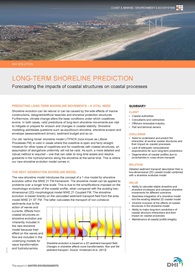Predicting long-term shoreline movements
Detailed sediment transport description from our two-dimensional (2D) coastal model, combined with a shoreline evolution model can help to effectively predict long-term shoreline movements.
 Detailed sediment transport description from our two-dimensional (2D) coastal model, combined with a shoreline evolution model can help to effectively predict long-term shoreline movements. Our solution can thereby enable long-term forecasts of impacts of coastal structures on coastal processes and thereby help maintain integrity of the coastline.
Detailed sediment transport description from our two-dimensional (2D) coastal model, combined with a shoreline evolution model can help to effectively predict long-term shoreline movements. Our solution can thereby enable long-term forecasts of impacts of coastal structures on coastal processes and thereby help maintain integrity of the coastline.
Valid predictions of long-term shoreline movements are vital to mitigate or prepare for erosion and changes in coastal stability. Our new shoreline model introduces the concept of a 1-line model for shoreline evolution within the MIKE 21 FM framework. The model can be applied to problems over a longer time scale. This is due to the simplifications imposed on the morphologic evolution of the coastal profile, when compared with the existing two-dimensional (2D) morphological model MIKE 21 Coupled FM.
Some of the key benefits of the new shoreline model:
- Ability to calculate stable shoreline and shoreline envelopes and compare shoreline movements for different scenarios
- Inherent inclusion of the effects of coastal structures in the shoreline model
- Ability to make long-term predictions of coastal structure interactions and their impact on coastal processes
- Maintenance of coastal profile integrity
Read more